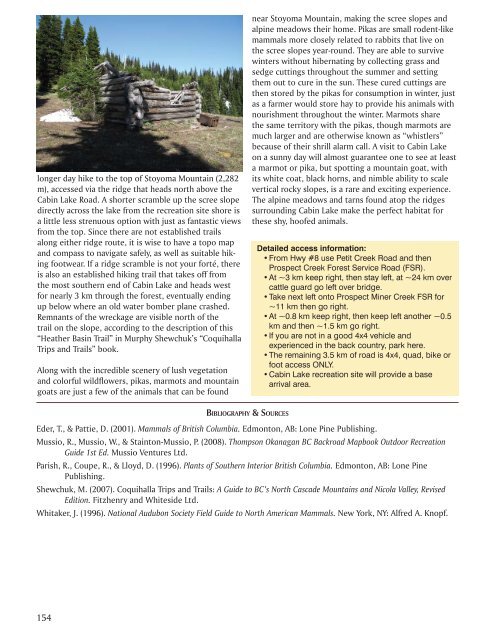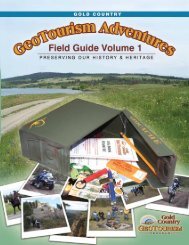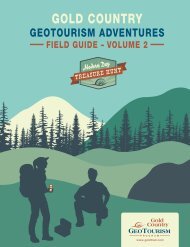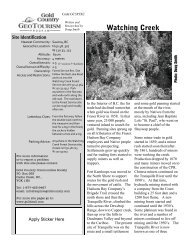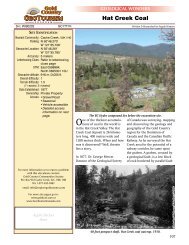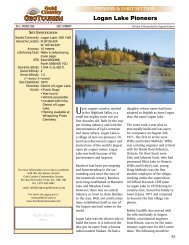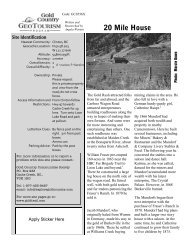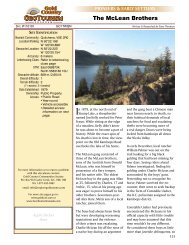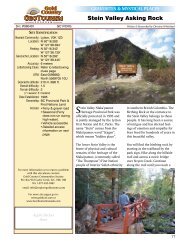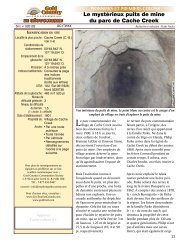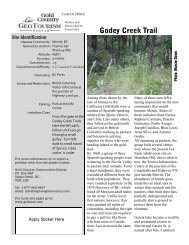E book Field Guide.indd - Gold Country
E book Field Guide.indd - Gold Country
E book Field Guide.indd - Gold Country
Create successful ePaper yourself
Turn your PDF publications into a flip-book with our unique Google optimized e-Paper software.
70 Mile House in 1955<br />
longer day hike to the top of Stoyoma Mountain (2,282<br />
m), accessed via the ridge that heads north above the<br />
Cabin Lake Road. A shorter scramble up the scree slope<br />
directly across the lake from the recreation site shore is<br />
a little less strenuous option with just as fantastic views<br />
from the top. Since there are not established trails<br />
along either ridge route, it is wise to have a topo map<br />
and compass to navigate safely, as well as suitable hiking<br />
footwear. If a ridge scramble is not your forté, there<br />
is also an established hiking trail that takes off from<br />
the most southern end of Cabin Lake and heads west<br />
for nearly 3 km through the forest, eventually ending<br />
up below where an old water bomber plane crashed.<br />
Remnants of the wreckage are visible north of the<br />
trail on the slope, according to the description of this<br />
“Heather Basin Trail” in Murphy Shewchuk’s “Coquihalla<br />
Trips and Trails” <strong>book</strong>.<br />
Along with the incredible scenery of lush vegetation<br />
and colorful wildflowers, pikas, marmots and mountain<br />
goats are just a few of the animals that can be found<br />
near Stoyoma Mountain, making the scree slopes and<br />
alpine meadows their home. Pikas are small rodent-like<br />
mammals more closely related to rabbits that live on<br />
the scree slopes year-round. They are able to survive<br />
winters without hibernating by collecting grass and<br />
sedge cuttings throughout the summer and setting<br />
them out to cure in the sun. These cured cuttings are<br />
then stored by the pikas for consumption in winter, just<br />
as a farmer would store hay to provide his animals with<br />
nourishment throughout the winter. Marmots share<br />
the same territory with the pikas, though marmots are<br />
much larger and are otherwise known as “whistlers”<br />
because of their shrill alarm call. A visit to Cabin Lake<br />
on a sunny day will almost guarantee one to see at least<br />
a marmot or pika, but spotting a mountain goat, with<br />
its white coat, black horns, and nimble ability to scale<br />
vertical rocky slopes, is a rare and exciting experience.<br />
The alpine meadows and tarns found atop the ridges<br />
surrounding Cabin Lake make the perfect habitat for<br />
these shy, hoofed animals.<br />
Detailed access information:<br />
• From Hwy #8 use Petit Creek Road and then<br />
Prospect Creek Forest Service Road (FSR).<br />
• At ~3 km keep right, then stay left, at ~24 km over<br />
cattle guard go left over bridge.<br />
• Take next left onto Prospect Miner Creek FSR for<br />
~11 km then go right.<br />
• At ~0.8 km keep right, then keep left another ~0.5<br />
km and then ~1.5 km go right.<br />
• If you are not in a good 4x4 vehicle and<br />
experienced in the back country, park here.<br />
• The remaining 3.5 km of road is 4x4, quad, bike or<br />
foot access ONLY.<br />
• Cabin Lake recreation site will provide a base<br />
arrival area.<br />
BIBLIOGRAPHY & SOURCES<br />
Eder, T., & Pattie, D. (2001). Mammals of British Columbia. Edmonton, AB: Lone Pine Publishing.<br />
Mussio, R., Mussio, W., & Stainton-Mussio, P. (2008). Thompson Okanagan BC Backroad Map<strong>book</strong> Outdoor Recreation<br />
<strong>Guide</strong> 1st Ed. Mussio Ventures Ltd.<br />
Parish, R., Coupe, R., & Lloyd, D. (1996). Plants of Southern Interior British Columbia. Edmonton, AB: Lone Pine<br />
Publishing.<br />
Shewchuk, M. (2007). Coquihalla Trips and Trails: A <strong>Guide</strong> to BC’s North Cascade Mountains and Nicola Valley, Revised<br />
Edition. Fitzhenry and Whiteside Ltd.<br />
Whitaker, J. (1996). National Audubon Society <strong>Field</strong> <strong>Guide</strong> to North American Mammals. New York, NY: Alfred A. Knopf.<br />
154


